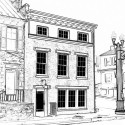 The reception and silent auction to celebrate the completion of the Samuel Noakes House on March 9 is drawing closer. While we count down until March 9, a number of items that will be available at the auction will be highlighted in the PHW blog.
The reception and silent auction to celebrate the completion of the Samuel Noakes House on March 9 is drawing closer. While we count down until March 9, a number of items that will be available at the auction will be highlighted in the PHW blog.
Two cold frames made by PHW Board Member Nancy Murphy from windows removed from the Noakes house will be available at the silent auction. One will be available during the afternoon showing, and one during the evening showing. Cold frames are used to protect plants from excessively cold or wet conditions. It functions like a greenhouse, extending the growing season for outdoor plants. A cold frame can be used to shelter tender seedlings in early spring or as the permanent home for cold-hardy fall and winter vegetables.
The re-purposed windows show early construction methods, including historic glass and pegged construction techniques. Until about the 1940s, window frames were usually made by a specialized type of carpenter, called a joiner. A joiner’s specialty is assembling wood using traditional techniques instead of mechanical means, such as nails and screws.
The joiner would usually construct window frames using mortise and tenon joints, as seen in these windows from the Noakes House. The tenon (a peg-like protrusion of wood, generally rectangular in shape) was inserted into the mortise (the hole) to weld the two pieces of wood together. A well-crafted joint will allow for the natural expansion and contraction of wood with humidity and temperature changes without causing splitting and cracking over time.
The cold frame windows have six lights, or panes of glass. Until the 1920s, all glass making procedures were labor-intensive, hands-on jobs for skilled craftsmen. Several approaches were available to produce window glass in the 18th and 19th centuries, though none produced the optically clear and bright glass we are familiar with today. Almost all historic glass contains imperfections of waves and/or trapped air bubbles from the manufacturing methods. In addition, the early methods to produce the glass limited the potential maximum size of the panes. The windows were therefore one of the greatest expenses in early construction.
To learn more about the historic construction techniques of windows, particularly glass and early carpentry, you may be interested in visiting The Colonial Williamsburg Foundation, Restoration Glass, and www.motherbedford.com/GlassTax.htm.
If you would like to own this practical, “up-cycled” piece of history, tickets are still available for both the afternoon and evening reception and silent auction on March 9. Reserve your spot online via PayPal, or make your reservation by mailing in a check payable to PHW to 530 Amherst St., Winchester, VA 22601.
 Afternoon Showing, 3-5 p.m. – $20 admission
Afternoon Showing, 3-5 p.m. – $20 admission
Evening Showing, 6-8 p.m. – $30 admission